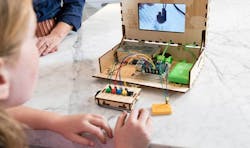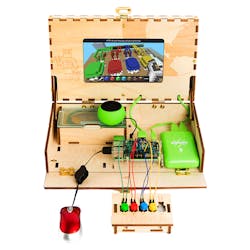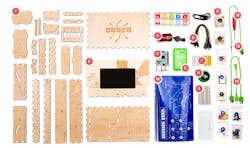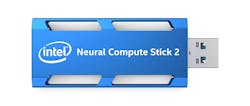As the holiday season rolls around, it’s time to hunt down some interesting electronic toys. We have an interesting collection for all ages.
1. The Piper Computer Kit is built around a Minecraft Raspberry Pi.
The first item on the list is Piper’s $299 Computer Kit (Fig. 1). This portable computer is assembled by children and company—it’s rated for children seven years and older. Younger children will likely need help a little assistance with both assembly and operation of the system that’s built around the Minecraft version of the Raspberry Pi 3 (Fig. 2).
2. Most children will require a little assistance to assemble the Piper Computer Kit.
The quad-core Raspberry Pi 3 runs at 1.2 GHz and contains 1 GB of memory. It has 802.11n Wi-Fi, Bluetooth 4.1, an Ethernet port, four USB ports, an HDMI port, a microphone/headphone combo jack for the speaker, and a MicroSD card slot for the OS. The HDMI port drives the LCD display, but could be connected to any HDMI display.
The kit includes precut wood pieces plus all of the components such as the Raspberry Pi 3 and a 7-in. LCD display. There’s a small USB mouse but no full-size keyboard, although adding a USB keyboard is just a matter of plugging it in. The box is rather large, so adding a keyboard makes the whole collection even larger. The system is designed to fold up like a rather large laptop, including a box for storing items. The system is battery-powered, making it somewhat mobile.
Playing Minecraft is just one avenue that can be explored with the kit. It includes patch boards, buttons, and wires for building all sorts of interesting experiments. Of course, the really ambitious can get into programming. This is part of the idea behind the Computer Kit that targets STEM education. The access to the Raspberry Pi 3 and the accompanying patch boards allow experimentation. The buttons and other interface components are designed to work with Minecraft.
The instructions don’t address more advanced programming and experimentation, but they do dig into construction, wiring, and other interface features that work with Minecraft and are included with the kit. Most adults without an electrical engineering degree should be able to assist in getting everything working. Older children, especially those who have worked with platforms like Erector or Meccano kits, can probably work through everything themselves.
Battery-powered operation has its benefits, but the provided battery limits use since it’s driving both the display and the Raspberry Pi 3. It’s possible to use the system with power bricks plugged into a wall outlet.
Overall, the kit is a great way to take advantage of a Raspberry Pi 3—for playing Minecraft with a customized peripheral interface as well as working on STEM projects. I’m saving the assembly for my oldest grandson, but I tried out the system without assembling the box. I haven’t played much Minecraft, so I got a bit of an education about it.
I can definitely recommend the kit for those who would like to supercharge Minecraft or learn about electronics or programming.
Playing with Neural Networks
For those a bit older who might find machine learning (ML) of interest, then check out Intel’s latest Neural Compute Stick 2 (NCS2) (Fig. 3). The $79 USB 3 module is designed to accelerate ML inference, allowing operations like real-time object recognition of video streams like a USB camera.
3. Intel’s Neural Compute Stick 2 includes 16 specialized vector 128-bit VLIW SHAVE (Streaming Hybrid Architecture Vector Engine) processors designed for machine-learning inference chores.
The NCS2 is built around the Myriad X VPU (video processing unit). The chip has a pair of RISC CPUs and 16 specialized vector 128-bit VLIW SHAVE (Streaming Hybrid Architecture Vector Engine) processors designed for ML inference chores with a bent toward image processing. The chip has 16 camera inputs, but these aren’t exposed by the USB stick.
Models come from ML frameworks like Caffe, TensorFlow, MxNet, and Kaldi. The OpenVINO software from Intel supports the ONNX interchange format as well. OpenVINO runs on Ubuntu and Windows. It can even work with the Raspberry Pi 3, although one will have to change the OS to use with the Piper Computer Kit.
Flying Neural Networks
Intel’s earlier Myriad 2 VPU chip can be found in a number of drones, including Ryze Robotics’ $99 Tello (Fig. 4) and DJI’s Spark. The ML chip provides features like image stabilization. The DJI Spark also uses the VPU to allow the drone to recognize gestures to assist in taking photographs.
4. Ryze Robotics’ Tello leverages Intel’s Myriad 2 VPU video processing unit.
The Tello keeps its price low by providing a 5-Mpixel image sensor that can record 720p video. It’s designed to be easy to use, including take off by tossing it into the air. The tiny quadcopter, which only weighs 80 g, has a flight time of 17 minutes, a speed of 8 m/s, and a range of 100 m.
The Tello is designed for indoor use. It can be used outdoors if there’s no wind, much like most compact drones that lack the power to deal with much more than a draft. The Scratch block-based visual programming tool provides one way of controlling the drone. There’s also an SDK for more advanced programming.
The 300 g DJI Spark is a bit more expensive; however, it sports a 12-Mpixel imaging chip. It also captures 1080p video. The flying time and range are similar to the Tello, but with a 14 m/s speed. It also works well outdoors. It uses dual-band Wi-Fi communication.
5. DJI’s Spark supports PalmControl using the Intel Myriad 2 VPU for taking flying selfies.
DJI’s FaceAware feature allows the Spark to take off from your hand by recognizing your face. It then hovers in place. The PalmControl mode gesture recognition makes taking selfies a snap, rather than having to use the handheld controller or a smartphone (Fig. 5). The drone also has an ActiveTrack feature for following and filming a target.
About the Author
William G. Wong
Senior Content Director - Electronic Design and Microwaves & RF
I am Editor of Electronic Design focusing on embedded, software, and systems. As Senior Content Director, I also manage Microwaves & RF and I work with a great team of editors to provide engineers, programmers, developers and technical managers with interesting and useful articles and videos on a regular basis. Check out our free newsletters to see the latest content.
You can send press releases for new products for possible coverage on the website. I am also interested in receiving contributed articles for publishing on our website. Use our template and send to me along with a signed release form.
Check out my blog, AltEmbedded on Electronic Design, as well as his latest articles on this site that are listed below.
You can visit my social media via these links:
- AltEmbedded on Electronic Design
- Bill Wong on Facebook
- @AltEmbedded on Twitter
- Bill Wong on LinkedIn
I earned a Bachelor of Electrical Engineering at the Georgia Institute of Technology and a Masters in Computer Science from Rutgers University. I still do a bit of programming using everything from C and C++ to Rust and Ada/SPARK. I do a bit of PHP programming for Drupal websites. I have posted a few Drupal modules.
I still get a hand on software and electronic hardware. Some of this can be found on our Kit Close-Up video series. You can also see me on many of our TechXchange Talk videos. I am interested in a range of projects from robotics to artificial intelligence.







